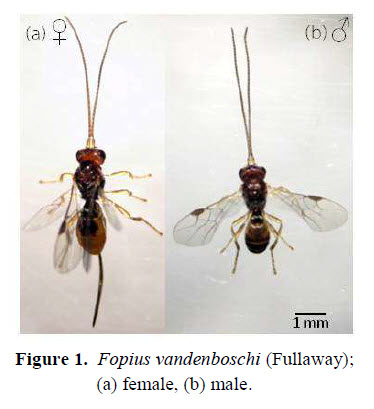Reproductive Biology of Fopius vandenboschi (Fullaway) (Hymenoptera: Braconidae) in the Laboratory
Keywords:
Fopius vandenboschi (Fullaway), Bactrocera, Reproductive biology, Natural enemies, Mass-rearingAbstract
Fopius vandenboschi (Fullaway) is one of the natural enemies of oriental fruit flies in genus Bactrocera. It is a koinobiont solitary endoparasitoid that parasitizes first and second instars of oriental fruit flies. The advantages of this parasitoid are the ability to parasitize several host species and the length of female longevity. Reproductive biology of F. vandenboschi in this research showed that it produced average 21.0±13.4 offspring per female, equivalent to net reproductive rate of 8.4 female offspring per generation. The sex ratio is equal to 0.6 : 0.4 (♂ : ♀) and the mean generation time of is 22.5 days. These results can be applied for mass-rearing
production of F. vandenboschi for inoculative and inundative release to enhance management populations of Bactrocera fruit fly pest in Thailand.
References
Bompard, A., Amat, I., Fauvergue, X., & Spataro, T. (2013). Host-parasitoid dynamics and the success of biological control when parasitoids are prone to Allee effects. PLoS ONE, 8(10),e76768. doi:10.1371/journal.pone.0076768
Chinajariyawong, A., Clarke, A. R., Jirasurat, M., Kritsaneepiboon, S., Lahey, H. A., Vijaysegaran,S., & Walter, G. H. (2000). Survey of opine parasitoids of fruit flies (Diptera: Tephritidae) in Thailand and Malaysia. The Raffles Bulletin of Zoology, 48(1), 71-101.
Clausen, C. P. (1978). Tephritidae (Trypetidae, Trupaneidae). In C. P. Clausen (Ed.), Introducedparasites and predators of arthropod pests andweeds: A world review (pp. 320-325). Washington, DC: U.S. Department of Agriculture.
Clausen, C. P., Clancy, D. W., & Chock, Q.C. (1965). Biological control of the oriental fruit fly (Dacus dorsalis Hendel) and other fruit flies in Hawaii. Washington, DC: U.S. Department of Agriculture.
Department of Agriculture Thailand. (2003a). Guava pest. Bangkok: Department of Agriculture.
Department of Agriculture Thailand. (2003b). Understanding natural enemies, IPM DANIDA. Bangkok: Department of Agriculture.
Godfray, H. C. J. (1994). Parasitoids: Behavioral and evolutionary ecology. New Jersey, UK: Princeton University Press.
Hagen, K. S. (1953). A premating period in certain species of the genus Opius (Hymenoptera:Braconidae). Proceedings of the Hawaiian Entomological Society, 15(1), 115-116.
Heimpel, G. E., & De Boer, J. G. (2008). Sex determination in the Hymenoptera. Annual Review of Entomology, 53, 209-230.
Koul, O., & Dhaliwal, G. S. (2003). Predators and parasitoids. London, UK: Taylor & Francis.
Ramadan, M. M. (2004). Mass-rearing biology of Fopius vandenboschi (Hym., Braconidae). Journal of Applied Entomology, 128, 226-232.
Ramadan, M. M., Wong, T. T. Y., & Messing, R. H. (1995). Reproductive biology of Biosteres vandenboschi (Hymenoptera: Braconidae), a parasitoid of early-instar oriental fruit fly.Annals of Entomological Society of America,88(2), 189-195.
Ramadan, M. M., Wong, T. T. Y., & Wong, M. A. (1991). Influence of parasitoid size and age on male mating success of Opiinae (Hymenoptera: Braconidae), larval parasitoids of fruit flies (Diptera: Tephritidae). Biological Control, 1(3), 248-255.
Shaw, M. R., & Huddleston, T. (1991). Classification and biology of braconid wasps (Hymenoptera: Braconidae). In W. R. Dolling, & R. R. Askew (Eds.), Handbooks for the identification of British insects. London: The Natural History Museum.
Stouthamer, R., Luck, R. F., & Werren, J. H. (1992). Genetics of sex determination and the improvement of biological control using parasitoids. Environmental Entomology, 21(3), 427-435.
Van Den Bosch, R., & Haramoto, F. H. (1953). Competition among parasites of oriental fruit fly. Proceedings of the Hawaiian Entomological Society, 15(1), 201-206.
Vargas, R. I., Leblanc, L., Harris, E. J., & Manoukis, N. C. (2012). Regional suppression of Bactrocera fruit flies (Diptera: Tephritidae) in the Pacific through biological control and prospects for future introductions into other areas of the world. Insects, 3(3), 727-742.
Vargas, R. I., Ramadan, M., Hussain, T., Mochizuki, N., Bautista, R. C., & Stark, J. D. (2002).Comparative demography of six fruit fly (Diptera: Tephritidae) parasitoids (Hymenoptera: Braconidae). Biological Control, 25, 30-40.
Vontas, J., Hernandez-Crespo, P., Magaritopoulos, J. T., Ortego, F., Feng, H.-T., Mathiopoulos, K. D.,& Hsu, J.-C. (2011). Insecticide resistance in Tephritid flies. Pesticide Biochemistry and Physiology, 100(3), 199-205.
Waterhouse, D. F. (1993). Biological control: Pacific prospects - Supplement 2. Canberra: Australian Centre for International Agricultural Research.
Wharton, R. A., & Gilstrap, F. E. (1983). Key to and status of opiine braconid (Hymenoptera) parasitoids used in biological control of Ceratitis and Dacus s.l. (Diptera: Tephritidae). Annals of the Entomological Society of America, 76(4), 721-742.













